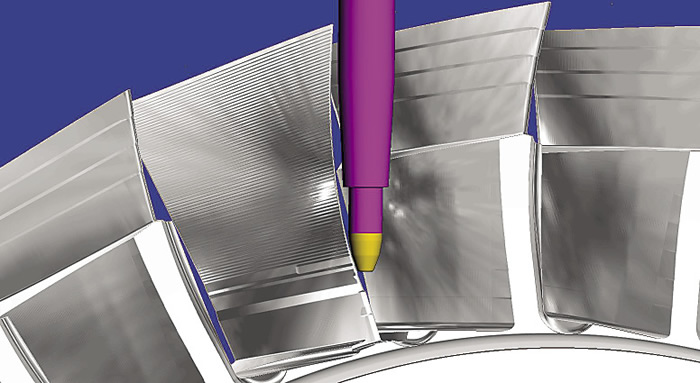Autodesk CAM software developer Delcam Ltd., working with toolmaker Technicut Ltd., has created a software and cutting tool combination for machining blisks that reportedly reduces machining time and costs about 50 percent compared to traditional methods.


PowerMILL image of a finishing operation on a blade barrel. Image courtesy Delcam.

The blisk has been an important turbo-engine component since it was introduced in the mid-1980s; prior to that, a rotor disk with individually attached blades was used. The blisk features blades and a disk as a single component, machined from a single piece of hard metal. Blisks offer advantages in weight, operating efficiency and through-life servicing but are challenging to manufacture because of their highly complex shapes and the difficulty of machining the materials used, usually a titanium or nickel-base alloy.
As with most machining projects, it comprises roughing, semifinishing and finishing. The initial roughing operation creates the blades with a series of slotting cuts using Technicut’s Titan X-Treme Ripper endmill.
In addition to removing the bulk of the material between what will be the blades, roughing relieves any stresses in the billet introduced during the forging process.
Both the semifinishing and finishing operations on the individual blades are then undertaken in a series of vertical sections, working from the tip downwards. The lower sections are left in the rough state to maintain the stiffness of the blade in the area being machined and, therefore, minimize push off of the blade tip by the cutter.
In addition to the specific toolpaths for blisk machining in Delcam’s PowerMILL software, the key to the new method is the use of barrel cutters from Technicut for semifinishing and finishing. The tools incorporate a much larger radius on their cutting surfaces than the ballnose endmills that would normally be applied, enabling the barrel cutters to achieve the same cusp height with a step-over up to three or four times as large. This larger step-over means fewer cutting passes are needed to achieve the specified surface finish, significantly reducing machining time.
A demonstration of the system, which can be seen on YouTube by entering tinyurl.com/CTE-bliskvideo, begins with a billet of 804mm-dia. (31.6”) Ti6Al4V titanium that is machined into a completed blisk with 31 blades, each 84mm (3.3”) in length with a root radius of 4mm (0.157”) and a scallop height of 10µm. The complete cycle time was 35 hours—less than half the time that would have been needed using conventional methods—while the cost of milling was reduced by 45 percent.
For more information about Delcam Ltd., Windsor, Ontario, call (877) 335-2261 or visit www.delcam.ca. For more information about Technicut Ltd., Sheffield, UK, e-mail [email protected] or visit www.technicut.ltd.uk.
Related Glossary Terms
- computer-aided manufacturing ( CAM)
computer-aided manufacturing ( CAM)
Use of computers to control machining and manufacturing processes.
- endmill
endmill
Milling cutter held by its shank that cuts on its periphery and, if so configured, on its free end. Takes a variety of shapes (single- and double-end, roughing, ballnose and cup-end) and sizes (stub, medium, long and extra-long). Also comes with differing numbers of flutes.
- gang cutting ( milling)
gang cutting ( milling)
Machining with several cutters mounted on a single arbor, generally for simultaneous cutting.
- milling
milling
Machining operation in which metal or other material is removed by applying power to a rotating cutter. In vertical milling, the cutting tool is mounted vertically on the spindle. In horizontal milling, the cutting tool is mounted horizontally, either directly on the spindle or on an arbor. Horizontal milling is further broken down into conventional milling, where the cutter rotates opposite the direction of feed, or “up” into the workpiece; and climb milling, where the cutter rotates in the direction of feed, or “down” into the workpiece. Milling operations include plane or surface milling, endmilling, facemilling, angle milling, form milling and profiling.
- slotting
slotting
Machining, normally milling, that creates slots, grooves and similar recesses in workpieces, including T-slots and dovetails.
- step-over
step-over
Distance between the passes of the toolpath; the path spacing. The distance the tool will move horizontally when making the next pass. Too great of a step-over will cause difficulty machining because there will be too much pressure on the tool as it is trying to cut with too much of its surface area.
- stiffness
stiffness
1. Ability of a material or part to resist elastic deflection. 2. The rate of stress with respect to strain; the greater the stress required to produce a given strain, the stiffer the material is said to be. See dynamic stiffness; static stiffness.


